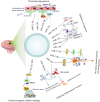Exosomal microRNAs as Potential Biomarkers and Therapeutic Agents for Acute Ischemic Stroke: New Expectations
- PMID: 35173663
- PMCID: PMC8842672
- DOI: 10.3389/fneur.2021.747380
Exosomal microRNAs as Potential Biomarkers and Therapeutic Agents for Acute Ischemic Stroke: New Expectations
Abstract
The morbidity and mortality rates of ischemic stroke (IS) are very high, and IS constitutes one of the main causes of disability and death worldwide. The pathogenesis of ischemic stroke includes excitotoxicity, calcium overload, oxygen radical injury, inflammatory reactions, necrosis/apoptosis, destruction of the blood-brain barrier (BBB), and other pathologic processes. Recent studies have shown that exosomes are critical to the pathogenesis, diagnosis, and treatment of cerebral infarctions resulting from ischemic stroke; and there is growing interest in the role of exosomes and exosomal miRNAs in the diagnosis and treatment of IS. Exosomes from central nervous system cells can be found in cerebrospinal fluid and peripheral bodily fluids, and exosomal contents have been reported to change with disease occurrence. Exosomes are small membranous extracellular vesicles (EVs), 30-150 nm in diameter, that are released from the cell membrane into the depressions that arise from the membranes of multivesicular bodies. Exosomes carry lipids, proteins, mRNAs, and microRNAs (miRNAs) and transport information to target cells. This exosomal transfer of functional mRNAs/miRNAs and proteins ultimately affects transcription and translation within recipient cells. Exosomes are EVs with a double-membrane structure that protects them from ribonucleases in the blood, allowing exosomal miRNAs to be more stable and to avoid degradation. New evidence shows that exosomes derived from neural cells, endothelial cells, and various stem cells create a fertile environment that supports the proliferation and growth of neural cells and endothelial cells, inhibits apoptosis and inflammatory responses, and promotes angiogenesis. In the present review, we discuss how circulating exosomes-and exosomal miRNAs in particular-may provide novel strategies for the early diagnosis and treatment of ischemic stroke via their potential as non-invasive biomarkers and drug carriers.
Keywords: acute ischemic stroke; diagnosis; exosomal miRNAs; mechanism; treatment.
Copyright © 2022 Xu, Hu, Xu, Liu and Gao.
Conflict of interest statement
The authors declare that the research was conducted in the absence of any commercial or financial relationships that could be construed as a potential conflict of interest.
Figures
Similar articles
-
Plasma neuronal exosomes serve as biomarkers of cognitive impairment in HIV infection and Alzheimer's disease.J Neurovirol. 2019 Oct;25(5):702-709. doi: 10.1007/s13365-018-0695-4. Epub 2019 Jan 4. J Neurovirol. 2019. PMID: 30610738 Free PMC article. Review.
-
Purification and microRNA profiling of exosomes derived from blood and culture media.J Vis Exp. 2013 Jun 14;(76):e50294. doi: 10.3791/50294. J Vis Exp. 2013. PMID: 23792786 Free PMC article.
-
Exosomal miRNAs as novel cancer biomarkers: Challenges and opportunities.J Cell Physiol. 2018 Sep;233(9):6370-6380. doi: 10.1002/jcp.26481. Epub 2018 Mar 25. J Cell Physiol. 2018. PMID: 29323722 Review.
-
Circulating exosomes and exosomal microRNAs as biomarkers in gastrointestinal cancer.Cancer Gene Ther. 2017 Feb;24(2):48-56. doi: 10.1038/cgt.2016.77. Epub 2016 Dec 16. Cancer Gene Ther. 2017. PMID: 27982021 Review.
-
Exosomal miRNAs in central nervous system diseases: biomarkers, pathological mediators, protective factors and therapeutic agents.Prog Neurobiol. 2019 Dec;183:101694. doi: 10.1016/j.pneurobio.2019.101694. Epub 2019 Sep 19. Prog Neurobiol. 2019. PMID: 31542363 Free PMC article. Review.
Cited by
-
Therapeutic Strategy of Mesenchymal-Stem-Cell-Derived Extracellular Vesicles as Regenerative Medicine.Int J Mol Sci. 2022 Jun 9;23(12):6480. doi: 10.3390/ijms23126480. Int J Mol Sci. 2022. PMID: 35742923 Free PMC article. Review.
-
Macrophage exosomal miR-30c-2-3p in atherosclerotic plaques aggravates microglial neuroinflammation during large-artery atherosclerotic stroke via TGF-β/SMAD2 pathway.J Neuroinflammation. 2024 Nov 8;21(1):292. doi: 10.1186/s12974-024-03281-7. J Neuroinflammation. 2024. PMID: 39511683 Free PMC article.
-
Exosomes in stroke management: A promising paradigm shift in stroke therapy.Neural Regen Res. 2026 Jan 1;21(1):6-22. doi: 10.4103/NRR.NRR-D-24-00665. Epub 2024 Dec 7. Neural Regen Res. 2026. PMID: 39665811 Free PMC article.
-
The dual function of microglial polarization and its treatment targets in ischemic stroke.Front Neurol. 2022 Sep 23;13:921705. doi: 10.3389/fneur.2022.921705. eCollection 2022. Front Neurol. 2022. PMID: 36212660 Free PMC article. Review.
-
Identification of ribosome biogenesis genes and subgroups in ischaemic stroke.Front Immunol. 2024 Sep 2;15:1449158. doi: 10.3389/fimmu.2024.1449158. eCollection 2024. Front Immunol. 2024. PMID: 39290696 Free PMC article.
References
-
- Przykaza Ł, Kozniewska E. Ligands of the neuropeptide Y Y2 receptors as a potential multitarget therapeutic approach for the protection of the neurovascular unit against acute ischemia/reperfusion: view from the perspective of the laboratory bench. Transl Stroke Res. (2021) 10.1007/s12975-021-00930-4 - DOI - PMC - PubMed
-
- Kanhai DA, de Kleijn DP, Kappelle LJ, Uiterwaal CS, van der Graaf Y, Pasterkamp G, et al. . Extracellular vesicle protein levels are related to brain atrophy and cerebral white matter lesions in patients with manifest vascular disease: the SMART-MR study. BMJ Open. (2014) 4:e003824. 10.1136/bmjopen-2013-003824 - DOI - PMC - PubMed
Publication types
LinkOut - more resources
Full Text Sources



